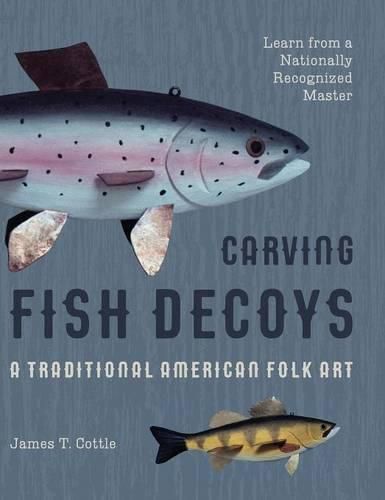Readings Newsletter
Become a Readings Member to make your shopping experience even easier.
Sign in or sign up for free!
You’re not far away from qualifying for FREE standard shipping within Australia
You’ve qualified for FREE standard shipping within Australia
The cart is loading…






This title is printed to order. This book may have been self-published. If so, we cannot guarantee the quality of the content. In the main most books will have gone through the editing process however some may not. We therefore suggest that you be aware of this before ordering this book. If in doubt check either the author or publisher’s details as we are unable to accept any returns unless they are faulty. Please contact us if you have any questions.
Fish decoys were originally used by Native and Early American ice fishermen to lure food fish within range of their spears. Carved and painted to mimic the appearance and behavior of prey for pike and muskies, the hand-crafted fish decoy has become enshrined in American culture as a treasured form of traditional folk art. Although the practicality –and sanity–of ice fishing with spears is up for debate, traditional fish decoys have been the subject of a recent surge of interest and have become highly sought-after, both as collectables and to be used under the ice.
If you’re someone who appreciates traditional American folk art and you want to learn to carve your own fish decoys, then this is the book for you. Life-long fisherman and decoy-carving instructor James Cottle makes it fun and easy to get started, with detailed instructions, contextual information, history lessons, and tool tips and techniques.
This book contains 22 traceable patterns for decoys including trout, perch, bass, suckers, pike, muskies, sunfish, and walleyes, plus a mouse and a frog. Every step of the process is described clearly, with instructions that will guide you through cutting, carving, weighting, painting, and adding fins and tail to your decoy. Then it’s ready to use–on your mantel or underwater. With color photographs of finished decoys and tips for developing your own painting style, this is the definitive guide to making your own traditional fish decoys.
$9.00 standard shipping within Australia
FREE standard shipping within Australia for orders over $100.00
Express & International shipping calculated at checkout
This title is printed to order. This book may have been self-published. If so, we cannot guarantee the quality of the content. In the main most books will have gone through the editing process however some may not. We therefore suggest that you be aware of this before ordering this book. If in doubt check either the author or publisher’s details as we are unable to accept any returns unless they are faulty. Please contact us if you have any questions.
Fish decoys were originally used by Native and Early American ice fishermen to lure food fish within range of their spears. Carved and painted to mimic the appearance and behavior of prey for pike and muskies, the hand-crafted fish decoy has become enshrined in American culture as a treasured form of traditional folk art. Although the practicality –and sanity–of ice fishing with spears is up for debate, traditional fish decoys have been the subject of a recent surge of interest and have become highly sought-after, both as collectables and to be used under the ice.
If you’re someone who appreciates traditional American folk art and you want to learn to carve your own fish decoys, then this is the book for you. Life-long fisherman and decoy-carving instructor James Cottle makes it fun and easy to get started, with detailed instructions, contextual information, history lessons, and tool tips and techniques.
This book contains 22 traceable patterns for decoys including trout, perch, bass, suckers, pike, muskies, sunfish, and walleyes, plus a mouse and a frog. Every step of the process is described clearly, with instructions that will guide you through cutting, carving, weighting, painting, and adding fins and tail to your decoy. Then it’s ready to use–on your mantel or underwater. With color photographs of finished decoys and tips for developing your own painting style, this is the definitive guide to making your own traditional fish decoys.